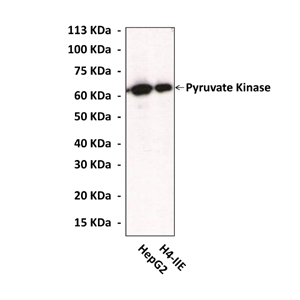Product Sheet CB6438
Description
BACKGROUND Pyruvate kinase (EC:2.7.1.40) (PK) catalyses the final step in glycolysis, the conversion of phosphoenolpyruvate to pyruvate with concomitant phosphorylation of ADP to ATP:1
“ADP + phosphoenolpyruvate = ATP + pyruvate”
The product pyruvate can be converted to acetyl CoA and can enter the TCA cycle. Under conditions where cells carry out anaerobic metabolism, the pyruvate is converted to lactate. It is now known that there are three isozymes of pyruvate kinase in human tissues. Isozyme I is found in erythrocytes and liver, isozyme II in kidney, and isozyme III in liver, kidney, leukocytes, skeletal muscle, and cardiac muscle.2
Pyruvate kinase is regulated indirectly by insulin and glucagon, which control a protein kinase. This protein kinase phosphorylates pyruvate kinase to inactivate it and dephosphorylates the enzyme to activate it. Glucagon signals fasting (no glucose available), and insulin signals the opposite. These two signaling molecules--in conjunction with the protein kinase--prevent pyruvate kinase from being active at the same time as the enzymes which catalyze the reverse reaction (pyruvate carboxylase and phosphoenolpyruvate carboxykinase), preventing a futile cycle.3 Pyruvate kinase also serves as a regulatory enzyme for gluconeogenesis, a biochemical pathway in which the liver generates glucose from pyruvate and other substrates. When pyruvate kinase is inhibited by phosphorylation (which occurs in the fasting state, via glucagon), phosphoenolpyruvate is prevented from conversion to pyruvate. Instead, it is converted to glucose in a series of gluconeogenesis reactions that are mostly (but not exactly) the reverse sequence of glycolysis. The glucose thus produced is expelled from the liver, providing energy for vital tissues in the fasting state.4
“ADP + phosphoenolpyruvate = ATP + pyruvate”
The product pyruvate can be converted to acetyl CoA and can enter the TCA cycle. Under conditions where cells carry out anaerobic metabolism, the pyruvate is converted to lactate. It is now known that there are three isozymes of pyruvate kinase in human tissues. Isozyme I is found in erythrocytes and liver, isozyme II in kidney, and isozyme III in liver, kidney, leukocytes, skeletal muscle, and cardiac muscle.2
Pyruvate kinase is regulated indirectly by insulin and glucagon, which control a protein kinase. This protein kinase phosphorylates pyruvate kinase to inactivate it and dephosphorylates the enzyme to activate it. Glucagon signals fasting (no glucose available), and insulin signals the opposite. These two signaling molecules--in conjunction with the protein kinase--prevent pyruvate kinase from being active at the same time as the enzymes which catalyze the reverse reaction (pyruvate carboxylase and phosphoenolpyruvate carboxykinase), preventing a futile cycle.3 Pyruvate kinase also serves as a regulatory enzyme for gluconeogenesis, a biochemical pathway in which the liver generates glucose from pyruvate and other substrates. When pyruvate kinase is inhibited by phosphorylation (which occurs in the fasting state, via glucagon), phosphoenolpyruvate is prevented from conversion to pyruvate. Instead, it is converted to glucose in a series of gluconeogenesis reactions that are mostly (but not exactly) the reverse sequence of glycolysis. The glucose thus produced is expelled from the liver, providing energy for vital tissues in the fasting state.4
REFERENCES
1. Muirhead H: Biochem. Soc. Trans. 18:193, 1990.
2. Larsen T M et al: Biochemistry 33:6301, 1994.
3. Miyanaga, O et al: J. Biol. Chem. 257:10617, 1982.
4. Clifton D et al: Genetics. 88:1-11, 1978.
2. Larsen T M et al: Biochemistry 33:6301, 1994.
3. Miyanaga, O et al: J. Biol. Chem. 257:10617, 1982.
4. Clifton D et al: Genetics. 88:1-11, 1978.
Products are for research use only. They are not intended for human, animal, or diagnostic applications.
Details
Cat.No.: | CB6438 |
Antigen: | E. coli-expressed protein containing N- & C-terminal sequences of human Pyruvate kinase. |
Isotype: | Rabbit IgG |
Species & predicted species cross- reactivity ( ): | Human |
Applications & Suggested starting dilutions:* | WB 1:1000 IP n/d IHC (Paraffin) n/d ICC n/d FACS n/d |
Predicted Molecular Weight of protein: | 62 kDa |
Specificity/Sensitivity: | Detects endogenous levels of Pyruvate Kinase |
Storage: | Store at -20°C, 4°C for frequent use. Avoid repeated freeze-thaw cycles. |
*Optimal working dilutions must be determined by end user.
Products
| Product | Size | CAT.# | Price | Quantity |
|---|---|---|---|---|
| Polyclonal Pyruvate Kinase Antibody : Polyclonal Pyruvate Kinase Antibody | Size: 100 ul | CAT.#: CB6438 | Price: $302.00 |

